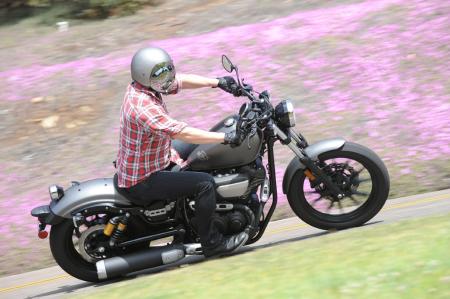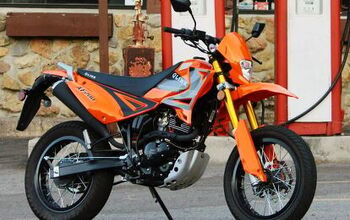2014 Star Motorcycles Bolt Review - Motorcycle.com
The reality TV stars have faded into obscurity. Blinged-out chopper sightings are fewer and farther between. The want ads are chock full of $50K customs at market-price markdowns.
Rejoice, true friends of the two-wheel brother (and sister) hood, for it would appear that the days of the high-dollar, trailer queen custom motorcycles are fully, completely behind us.
Now, no one’s dissing the trend. Art reflects its times, and most customs produced in the American Chopper era were certifiable works of industrial art, with style, craftsmanship and componentry to be admired. But even – no, especially – in art, form follows function, and it took but a decade or so before the truth won out: most of these fabulous showpieces made for gawdawful motorcycle rides. The tanked economy didn’t help matters, but the fact remains: the market has turned toward bikes that serve a function beyond the stage.
Café racers and bobbers rule the custom scene these days, and even OEMs are turning toward simpler, back-to-basics bikes to attract retail buyers. Harley was likely the first to respond to the trend with its Nightster and Iron 883 Sportsters, but that’s no surprise: when it comes to new product, the Motor Company typically holds its finger on the pulse on the custom market. Then the Japanese cruisers usually follow in short order. (European OEMs just seem to do their own thing – the obvious key to their appeal.)
To that end, Yamaha’s Star Motorcycles announced at last month’s Daytona Bike Week the arrival of its “urban performance bobber,” the 2014 Bolt. Powered by the same air-cooled 60-degree V-Twin that powers the V Star 950 and featuring discreet paint schemes, steampunk-ish styling and utilitarian componentry, the Bolt is poised to provide a streetwise counterpoint to the Harley-Davidson Iron 883 when it arrives in showrooms at the end of this month.
As our man Tom Roderick pointed out in his preview, the Bolt has a nearly 59cc displacement advantage over the Iron, and is 33 pounds lighter than the Harley. The $7990 price tag is curious on a couple of levels; as appealing as that price point appears at first glance, it’s just nine dollars less than the Iron 883. Not that that’s not inexpensive, mind you. For that kind of coin, a brand-new, liter-size non-standard bike should be considered a bargain by any new-bike-shopper’s standards.
Still, Japanese cruisers are usually viewed as budget alternatives to Big Daddy Harley, and that’s not the case here. So on a recent ride around San Diego to evaluate the Bolt’s performance and curb appeal, we were also out to determine if the Star’s evident spec-sheet advantages justified its competitive price tag.
Nuts And Bolts
Featuring a healthy V-Twin pulse and low, guttural throat, the Bolt’s 942cc powerplant differs from its V Star brother’s mainly in its tuning. The componentry is nearly identical, but thanks to a smaller airbox (2.3 liters versus the V Star’s three-liter job) and adjusted fuel management settings, the Bolt brings the grunt down low, pulling from the line with aplomb and powering up to highway speeds in a flash.
It achieves its street smarts using Mikuni fuel injection (with 3D mapping) and a dual-bore throttle body with healthy 35mm entryways – each with its own injector. The closed-loop system constantly adjusts for altitude and the like, and also provides strong and smooth throttle response and easy starting. Although Star hasn’t released MPG numbers, it says fuel economy will be excellent.
Even though the V-Twin’s muscular heads protrude from underneath the Bolt’s backbone, the ceramic composite-lined cylinder walls seemed to dissipate temperature efficiently on our ride in San Diego, so engine heat shouldn’t detract from the rider’s comfort. With four valves per cylinder, aluminum pistons and a 60-degree vee angle, the mill proved more than enough engine for a bike of this size and caliber.
Thanks to its lively motor and responsive handling, the Bolt will make a great commuter for anyone with a desire to look cool while gettin’ there. That responsiveness comes from a short, 61.8-inch wheelbase and steering geometry (29-degree rake and 130mm trail) that’s sporty for a cruiser.
Despite its studly deportment, the Bolt is light and nimble on the road, and particularly compliant at slow-speed maneuvers. The 27.2-inch seat height and narrow saddle mean the 540-pound (wet) machine is an easy bike to walk into tight spaces when needed. But the bike’s lightness and maneuverability become even more manifest when it’s being hustled around town by 58 cubic inches of engine torque.
Lane-splitting in San Diego’s congested Gaslamp Quarter and downtown area was a delight, especially when the traffic light turned green and the cagers disappeared meekly into the oblivion of my (subtle-yet-ample) rear view mirrors. On the freeway, changing lanes required nothing more than a slight shift in body weight or light pressure on the handlebar. Whether cruising at highway speed or negotiating traffic, this bike begs to be thrown around by an eager rider.
The five-speed transmission is ideally proportioned, providing long, even throws throughout the range. There was no jarring feedback when downshifting, adding to the Bolt’s affable nature in city traffic; Star credits the tranny’s straight-cut gear dogs, and we’ll take their word for it. At cruising speeds, fifth gear provided plenty of room for the engine to stretch out and still reserved a healthy amount of throttle response; passing dawdling drivers required no gear changes. Clutch actuation is light and breezy, and even after a long day of full-tilt urban assault, my left hand felt zero fatigue.
As for the technical aspects of the Bolt, I’ve saved the most notable characteristic for last. Even on modern production models, suspension on bikes of this ilk is notoriously brutal – the Iron 883 is so punishing it should come with a bar-and-shield branded kidney belt, standard. Star addresses the issue with twin KYB shocks under the seat that offer 2.8” of travel. Granted, that’s not a lot of room to bounce, but the shocks are pre-load adjustable and besides, the stubbed springs are necessary to maintain the bike’s low seat height and center of gravity. And they work just fine, thank you.
The bottom line is the stock shocks are as suited to city riding as the rest of the bike. The consensus among the testers on our press launch was that the Bolt’s suspension is far and away superior to the Iron’s, and it’s not at all close. Sure, creases, rumples and seams made themselves apparent and hard bumps were still quite jarring, but on a bike such as this, you expect to feel the road.
Street Style
“Street smart” can be defined as exuding style without calling too much attention to oneself. To that end, the Bolt is attractive through its confidence, not its fashion. Raw metal, modest styling and restrained cosmetics put forth an air of poise and self-assuredness – there’s nothing here to suggest arrogance or conceit, no accent chrome to be found except on the headlight ring and mirrors (the gas cap doesn’t count).
Instrumentation is limited to a single bar-mounted, smoked lens LCD digital meter that goes black when the key is off. A tab on the right switchgear lets you scroll through the odo, two tripmeters and a clock, but that’s the full extent of the creature comforts on this bike. As with all Star cruisers, steel fenders provide customizers the option to fire up the torch, if so desired. Color options? The standard Bolt comes in black (no graphics) or white (small painted tank logo).
The R-Spec Bolt turns up the style, but only slightly. Fact is, the name is rather a misnomer. The term usually refers to a bike outfitted with performance modifications, but that’s (sadly) not the case here (yet). Pony up the 300 bucks extra for the R and you’ll get the aforementioned anodized remote-reservoir shocks, black mirrors, and a faux suede seat with colored stitching.
The Star Custom Accessories division pitches in with a bullet-nose fairing, high z-type handlebar, fork gaiters, two-up seat, sissy bar with passenger backrest, small but stylish brown leather saddlebags, brass-finished accents, and more.
Bottom Line
Whether or not the Star Bolt matches up with Harley’s Iron 883 is an evaluation best left for our upcoming shootout. But does the bike merit a price tag that’s in the same ballpark as the American icon’s?
The answer is an unequivocal “Hell yeah.” I expected to like the Bolt, but I did not expect to enjoy riding it as much as I did. Ample power, responsive handling, great looking – it’s everything you could want in a city cruiser. Right off the showroom floor, it would make a cool ride for an experienced urban commuter and would also serve as a decent beginner bike – perhaps not for a completely inexperienced rider, but the young newbie who wants a bike he can be proud to ride for years to come could certainly do worse.
If you’re shopping for a two-wheeled urban assault vehicle such as a Sportster 883 or even a Triumph Bonneville, Star just made your decision a whole lot harder.
Be sure to check out our gallery of images from the launch of the 2014 Star Bolt.
Related Reading
2014 Star Bolt Preview
2012 Star V Star 950 Review
2012 Harley-Davidson Sportster SuperLow vs. Triumph America - Video
Shootout: 2010 Honda Shadow RS vs. 2010 Harley-Davidson 883 Low
2009 Harley-Davidson Iron 883 Review
2009 Triumph Bonneville Review
Mainstream Choppers Shootout
2006 Light-Middleweight Cruiser Comparison
2006 Triumph Bonneville Scrambler vs. Harley-Davidson Sportster 1200R – McQueen vs. Knievel
More by Jon Langston






































Comments
Join the conversation